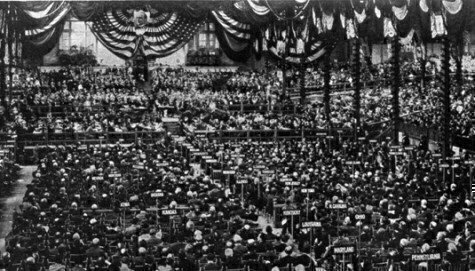In part two of a series about the history of political conventions hosted in Philadelphia, we look three at very different GOP-related national conventions in the days when Republicans controlled the City of Brotherly Love in the post-Civil War era.

Philadelphia was the nation’s second biggest city when the Civil War began in 1861 and it soon became a political center for the emerging Republican Party and what was called the National Union Party in the 1864 election. (The National Union name allowed the GOP to include Democrats who supported the Union cause in its ranks.)
Read Part One: Philly hosts Whigs, Know Nothings and first GOP convention
The city hosted three major party conventions between 1866 and 1900, with the 1900 convention introducing Theodore Roosevelt to the national political stage as a vice presidential candidate. The first convention was a rare mid-term meeting that led to one of biggest public relations disasters in American history: President Andrew Johnson’s “Swing Around The Circle” speaking tour. The second convention led to the successful renomination of Ulysses S. Grant as President.
1866: The National Union Mid-Term Convention
The August 1866 meeting of the National Union party’s remnants in Philadelphia was an attempt by President Johnson to unite conservative Republicans with Democrats, in his fight with the Radical Republicans. Johnson’s proposed lenient terms for Reconstruction in the South infuriated the Radical Republicans, and both sides saw the 1866 mid-term elections as critical in their bitter struggle.
Johnson’s supporters were especially upset with the 14th Amendment passed by a Congress controlled by the Radical Republicans. On the night that Congress approved the landmark amendment, Johnson called for a national convention to deal with the Radicals.
The group met in Philadelphia, and while the 14th Amendment wasn’t mentioned by name, the guest speakers railed against the Reconstruction supporters. They also called for total support for Johnson and the immediate readmission of the former Confederate states.
Emboldened by the convention, Johnson decided to take his party leaders on a whirlwind speaking tour. The “Swing Around The Circle” tour would start near Philadelphia, head to the Midwest, and then head back East. Confronted by hecklers at several speeches, Johnson used vulgar language, threatened to harm the Radicals and also compared himself to Jesus. The Radicals also claimed Johnson was drunk during his speeches. The National Union Party faced severe losses in the 1866 election, leaving Johnson facing an angry Congress.
1872: Grant nominated and Vice Presidential drama
The next official Republican gathering in Philadelphia was six years later in June 1872, when the Party faced a decision on President Ulysses S. Grant’s nomination. During Grant’s first administration, the controversy over Reconstruction continued, and in May 1872, an anti-Radical Republican group split from the party. Called the Liberal Republicans, they nominated newspaper editor Horace Greeley as their presidential candidate.
In Philly, there were three days of celebrations at the Academy of Music with no opposition at the convention to Grant. However, there was considerable debate about incumbent Vice President Schuyler Colfax. The former House speaker had declared he would not run for any election in 1872, but he refused a request from Grant to resign and accept the position of Secretary of State – an indicator that Colfax was pondering a challenge to Grant for the presidential nomination. In the end, the convention rejected Colfax for Henry Wilson of Massachusetts as Grant’s running mate.
1900: McKinley names Teddy as VP pick
In June 1900, the Republicans gathered at a large temporary auditorium near Philadelphia’s Schuylkill River to approve a second term for William McKinley, who had defeated William Jennings Bryan four years earlier. But McKinley’s Vice President, Garret Hobart, had died a year earlier, and there was much speculation about the next vice presidential nominee.
One name in the initial mix was New York Governor Theodore Roosevelt. But on June 16, the Philadelphia Inquirer reported that the popular Roosevelt “absolutely refused” to have his name put into nomination, but Roosevelt would be easily nominated if he did run. President McKinley had wanted Senator William Allison as his running mate, but Allison refused. And Mark Hanna, McKinley’s campaign manager, hated Roosevelt.
In a political twist, Thomas Platt, the political boss of New York state, hated Roosevelt, too, and Platt worked with Pennsylvania boss Matthew Quay to get Roosevelt on the ballot – as a way to get Roosevelt out of New York politics.
Roosevelt was forced to accept the nomination by popular acclaim after McKinley refused Hanna’s pleas to use the party’s patronage system to block Roosevelt. An agitated Hanna allegedly remarked, “There’s only one life between that madman and the Presidency.”







